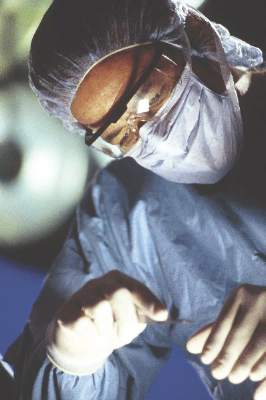User login
Junior-level residents are getting less operative experience in some common general surgery procedures, a large case review study has found.
The rise in laparoscopic surgery and the decline of open procedures have been accompanied by a reduction in junior resident participation in what previously would have been considered junior-level cases, reported Matthew Mullen, MD, and his associates at the department of surgery, University of Virginia, Charlottesville (J Surg Educ. 2016 August. doi: 10.1016/j.jsurg.2016.02.010).
“The general response from the surgical community has been that this issue would correct over time, and the distribution of cases to junior residents would normalize,” the investigators explained. In the present study, the investigators “sought to evaluate continuing trends in case distribution among junior and senior residents.”
A total of 185,335 surgical cases performed between 2005 and 2012, identified through a query of the Participant Use Data File, were analyzed. Junior residents were defined as PGY1-3. Of the surgical cases reviewed, 30.2% were appendectomies, 21.9% were inguinal herniorrhaphies, 14.2% were colectomies, and 33.8% were cholecystectomy.
Over the 8-year period, 66% of those procedures were laparoscopic, and each year the likelihood of surgery being performed laparoscopically increased steadily for appendectomy, inguinal herniorrhaphy, and colectomy but remained the same for cholecystectomies.
In the same 8-year period, the likelihood of junior resident participation across all of these procedures decreased by an average of 5.3% per year. This decrease was most drastic for laparoscopic cholecystectomy at 6.2% per year while participation did not change for laparoscopic inguinal herniorrhaphy and increased by 3.9% for partial colectomy.
Junior level participation in open surgeries over the 8 years also decreased by 9.4% for appendectomy, 10% for inguinal herniorrhaphy, 2.9% for partial colectomy, and 4.1% for cholecystectomy.
Among the limitations of the study, the data did not show whether the lack of operative experience among junior residents was compensated for in their senior year or if these patterns differed between academic and community training environments.
“The reason for diminishing junior resident case volume for the basic general surgery procedures we examined is not truly known. It is possible that these common and technically straightforward cases, traditionally the training ground for junior residents, now require advanced laparoscopic skills and therefore are no longer appropriate for junior-level residents,” Dr. Mullen and his associates wrote.
Nonetheless, the decline of junior resident participation in these procedures will have significant implications for general surgery resident education, the investigators concluded.
This study was funded by the National Institutes of Health. Author disclosures were not reported.
Junior-level residents are getting less operative experience in some common general surgery procedures, a large case review study has found.
The rise in laparoscopic surgery and the decline of open procedures have been accompanied by a reduction in junior resident participation in what previously would have been considered junior-level cases, reported Matthew Mullen, MD, and his associates at the department of surgery, University of Virginia, Charlottesville (J Surg Educ. 2016 August. doi: 10.1016/j.jsurg.2016.02.010).
“The general response from the surgical community has been that this issue would correct over time, and the distribution of cases to junior residents would normalize,” the investigators explained. In the present study, the investigators “sought to evaluate continuing trends in case distribution among junior and senior residents.”
A total of 185,335 surgical cases performed between 2005 and 2012, identified through a query of the Participant Use Data File, were analyzed. Junior residents were defined as PGY1-3. Of the surgical cases reviewed, 30.2% were appendectomies, 21.9% were inguinal herniorrhaphies, 14.2% were colectomies, and 33.8% were cholecystectomy.
Over the 8-year period, 66% of those procedures were laparoscopic, and each year the likelihood of surgery being performed laparoscopically increased steadily for appendectomy, inguinal herniorrhaphy, and colectomy but remained the same for cholecystectomies.
In the same 8-year period, the likelihood of junior resident participation across all of these procedures decreased by an average of 5.3% per year. This decrease was most drastic for laparoscopic cholecystectomy at 6.2% per year while participation did not change for laparoscopic inguinal herniorrhaphy and increased by 3.9% for partial colectomy.
Junior level participation in open surgeries over the 8 years also decreased by 9.4% for appendectomy, 10% for inguinal herniorrhaphy, 2.9% for partial colectomy, and 4.1% for cholecystectomy.
Among the limitations of the study, the data did not show whether the lack of operative experience among junior residents was compensated for in their senior year or if these patterns differed between academic and community training environments.
“The reason for diminishing junior resident case volume for the basic general surgery procedures we examined is not truly known. It is possible that these common and technically straightforward cases, traditionally the training ground for junior residents, now require advanced laparoscopic skills and therefore are no longer appropriate for junior-level residents,” Dr. Mullen and his associates wrote.
Nonetheless, the decline of junior resident participation in these procedures will have significant implications for general surgery resident education, the investigators concluded.
This study was funded by the National Institutes of Health. Author disclosures were not reported.
Junior-level residents are getting less operative experience in some common general surgery procedures, a large case review study has found.
The rise in laparoscopic surgery and the decline of open procedures have been accompanied by a reduction in junior resident participation in what previously would have been considered junior-level cases, reported Matthew Mullen, MD, and his associates at the department of surgery, University of Virginia, Charlottesville (J Surg Educ. 2016 August. doi: 10.1016/j.jsurg.2016.02.010).
“The general response from the surgical community has been that this issue would correct over time, and the distribution of cases to junior residents would normalize,” the investigators explained. In the present study, the investigators “sought to evaluate continuing trends in case distribution among junior and senior residents.”
A total of 185,335 surgical cases performed between 2005 and 2012, identified through a query of the Participant Use Data File, were analyzed. Junior residents were defined as PGY1-3. Of the surgical cases reviewed, 30.2% were appendectomies, 21.9% were inguinal herniorrhaphies, 14.2% were colectomies, and 33.8% were cholecystectomy.
Over the 8-year period, 66% of those procedures were laparoscopic, and each year the likelihood of surgery being performed laparoscopically increased steadily for appendectomy, inguinal herniorrhaphy, and colectomy but remained the same for cholecystectomies.
In the same 8-year period, the likelihood of junior resident participation across all of these procedures decreased by an average of 5.3% per year. This decrease was most drastic for laparoscopic cholecystectomy at 6.2% per year while participation did not change for laparoscopic inguinal herniorrhaphy and increased by 3.9% for partial colectomy.
Junior level participation in open surgeries over the 8 years also decreased by 9.4% for appendectomy, 10% for inguinal herniorrhaphy, 2.9% for partial colectomy, and 4.1% for cholecystectomy.
Among the limitations of the study, the data did not show whether the lack of operative experience among junior residents was compensated for in their senior year or if these patterns differed between academic and community training environments.
“The reason for diminishing junior resident case volume for the basic general surgery procedures we examined is not truly known. It is possible that these common and technically straightforward cases, traditionally the training ground for junior residents, now require advanced laparoscopic skills and therefore are no longer appropriate for junior-level residents,” Dr. Mullen and his associates wrote.
Nonetheless, the decline of junior resident participation in these procedures will have significant implications for general surgery resident education, the investigators concluded.
This study was funded by the National Institutes of Health. Author disclosures were not reported.
FROM THE JOURNAL OF SURGICAL EDUCATION
Key clinical point: Junior resident participation in certain general open and laparoscopic surgeries decreased from 2005 to 2012.
Major finding: Likelihood of junior resident participation in all procedures decreased by 5.3% per year over the 8-year period.
Data source: Meta-analysis of 185,335 surgical cases.
Disclosures: This study was funded by the National Institutes of Health. Author disclosures were not reported.

